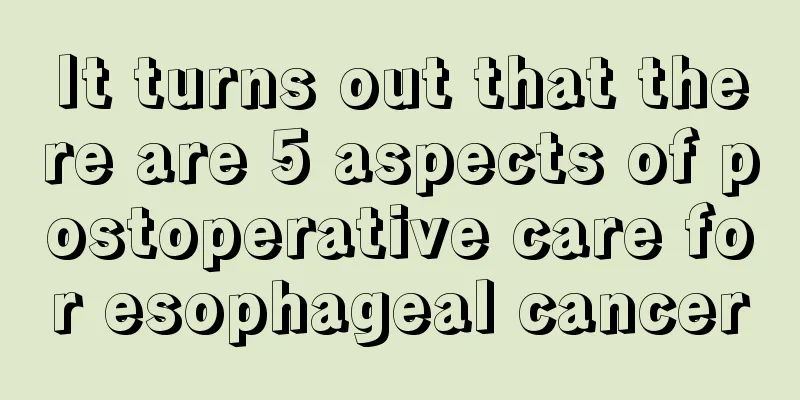It turns out that there are 5 aspects of postoperative care for esophageal cancer

|
As we all know, esophageal cancer is extremely harmful to human health, so timely surgical treatment is very necessary. So what kind of care is needed after esophageal cancer surgery? Many esophageal cancer patients are not very familiar with this. In fact, there are five aspects that need to be paid attention to after esophageal cancer surgery, and oral hygiene is one of them. 1. Pay attention to oral hygiene The oral cavity is the first gateway to the digestive tract and is itself a place where bacteria grow in large numbers. Therefore, oral hygiene after surgery is very important for patients. You can use a cotton swab to wipe your mouth 1-2 days after surgery. Try not to swallow saliva or sputum before removing the gastric tube to reduce the chance of esophageal anastomosis infection. You should brush your teeth every morning and evening, and rinse your mouth three to five times a day with mouthwash or light salt water at irregular intervals. If you often feel dry mouth, you can also rinse your mouth with light green tea or lemon water to relieve the feeling of dry mouth. 2. Keep the airway open After esophageal cancer surgery, especially within 1 week after surgery, patients should pay attention to keeping their airways open to avoid poor sputum discharge and retention of secretions, which may cause lung infection. Do several sets of deep breathing exercises and effective coughing every day. Family members or caregivers should help the patient cough and expectorate: put five fingers together, half-clench a fist and tap the patient's back from bottom to top, 2-3 times a day. Pay attention to hygiene and prevent colds. If the patient experiences symptoms such as high fever, chest pain, and difficulty breathing, he or she must seek medical attention promptly. 3. Adhere to rehabilitation exercises Since thoracotomy requires cutting of the chest muscles, muscle adhesion must be prevented after the operation to prevent ankylosis of the shoulder joint and muscle disuse atrophy on the operated side. After you are fully awake after the operation, you can start moving your limbs, especially the upper limb on the operated side. By flexing and extending your fingers and forearms and massaging the muscles around the shoulder, you can reduce soreness and numbness. Encourage the patient to use the operated hand to do activities within his ability, such as brushing teeth, combing hair, etc. As physical strength recovers, gradually increase the amount and range of activities, such as lifting the upper limbs, hyperextension of the arms, chest expansion exercises, adduction or flexion of the upper limbs, and adduction of the shoulder blades. You can also consciously use the affected upper limb to comb your hair, hold a bowl, touch the opposite ear over the top of your head, climb the wall with your fingers, etc. But be careful not to let your head and neck tilt, try to keep it in a natural position. If you need to stay in bed for a long time after surgery, you should pay attention to preventing deep vein thrombosis in the lower limbs. After waking up from surgery, you can do ankle flexion exercises. At the same time, according to the body's tolerance, appropriate lower limb activities should be performed with the assistance of family members, such as leg stretching, empty bicycle pedaling, etc., to promote blood circulation in the lower limbs. 4. Family diet regimen After esophageal cancer surgery, the normal physiological state of the patient's digestive tract is changed, the stomach is pulled up to the chest cavity to form a "chest stomach"; the vagus nerve that controls gastric peristalsis is cut off, and the patient may not feel full or hungry after surgery; the gastroesophageal anastomosis does not have the function of the cardiac sphincter, and lying flat can easily cause reflux of gastric contents and lead to reflux esophagitis; the re-anastomotic esophagus has a special and fragile structure, and if the diet is not handled properly, it will lead to postoperative anastomotic fistula or anastomotic stenosis. Therefore, patients should follow the following eating procedures after surgery: Nasogastric feeding stage: usually 1-5 days after surgery. At this time, the surgical anastomosis has not yet healed, gastrointestinal function has not yet recovered, and the digestive function is poor. Nutrition can only be delivered directly to the jejunum using a nasogastric tube. Liquid diet phase: usually 5-10 days after surgery. At this point, the patient has basically passed the surgical trauma period, intestinal motility has recovered, the nasogastric tube has been removed, and he can eat residue-free liquid food. The main drink is water, and you can eat rice soup, egg soup, and various poultry and fish soups. Semi-liquid diet stage: Generally, a semi-liquid diet is started on the 12th day after surgery, mainly consisting of light and easily digestible foods (such as porridge, noodles, egg custard, tofu, etc.). At this time, you should still eat small meals frequently to promote the recovery of digestive function. Normal diet: about 4 weeks after surgery. Anastomotic stenosis may occur after surgery, and eating solid food has a certain dilating effect on the anastomosis. Therefore, it is not advisable to eat a semi-liquid diet for a long time after surgery. In the early stage, the main food intake should be easily digestible, high-protein, high-vitamin foods, such as milk, eggs, lean meat, fish, shrimp, fruits and fresh vegetables. At the same time, you should develop the habit of eating at regular times and in regular quantities. Note: 1. Avoid tobacco, alcohol, coffee, fried, irritating or hard food, and do not eat acidic or alkaline food. 2. It is not advisable to lie down immediately after a meal to avoid food reflux and cause palpitations, cold sweats and other hypoglycemia-like reactions. It is best to lie down for 30 minutes or walk for 30 minutes after eating. 3. Chew slowly when eating, and the food temperature should be between 40℃ and 42℃ to prevent burns, food stuck in the stomach or bone damage to the esophagus. 5. Psychological and spiritual care Family members should first adjust their emotions, create a good and comfortable family atmosphere, help patients build confidence in overcoming the disease, and avoid negative emotions such as pessimism and negativity. Try not to let the patient live alone to avoid loneliness and depression. A regular routine and good sleep can prevent depression. Appropriate outdoor and social activities can help patients maintain a cheerful, happy mood and a positive and optimistic attitude towards life. |
<<: What to do if the outer skin of your eyes is itchy? 6 things to pay attention to
>>: It turns out that the diet after esophageal cancer surgery can be divided into these four stages
Recommend
Can I eat pineapple if I have high blood sugar? What are the benefits?
Pineapple is the most common fruit in March and A...
What are the symptoms of nasal complex infection
Rhinitis syndrome infection is a relatively commo...
What are the early symptoms of cervical cancer
Cervical cancer may not have obvious symptoms in ...
Can bronchial lung cancer be detected by CT?
Can bronchial lung cancer be detected by CT? Bron...
Examination of sputum exfoliated cells in patients with primary lung cancer
Patients with primary lung cancer can undergo spu...
Glycated hemoglobin 9
Many people often have some different changes in ...
How is fat excreted from the body?
The human body can eliminate fat smoothly through...
Reasons for acne on the cheeks and neck
Acne is a common symptom. There are many reasons ...
How can I grow more hair?
When people reach middle age, not only do their b...
Is it normal to have blood in leucorrhea after stopping progesterone?
Progesterone is a drug used for abortion. When pe...
Can aloe vera gel remove red blood streaks?
The red blood streaks on the face are distressing...
Why does drinking water make you gain weight?
Why do some people gain weight by drinking water?...
What does a spoiled Zongzi look like
When people choose rice dumplings, they need to l...
Face tightening exercise
As we age, our skin begins to sag. Especially whe...
What's wrong with my thighs being swollen
What is the reason for thigh swelling? The sympto...









